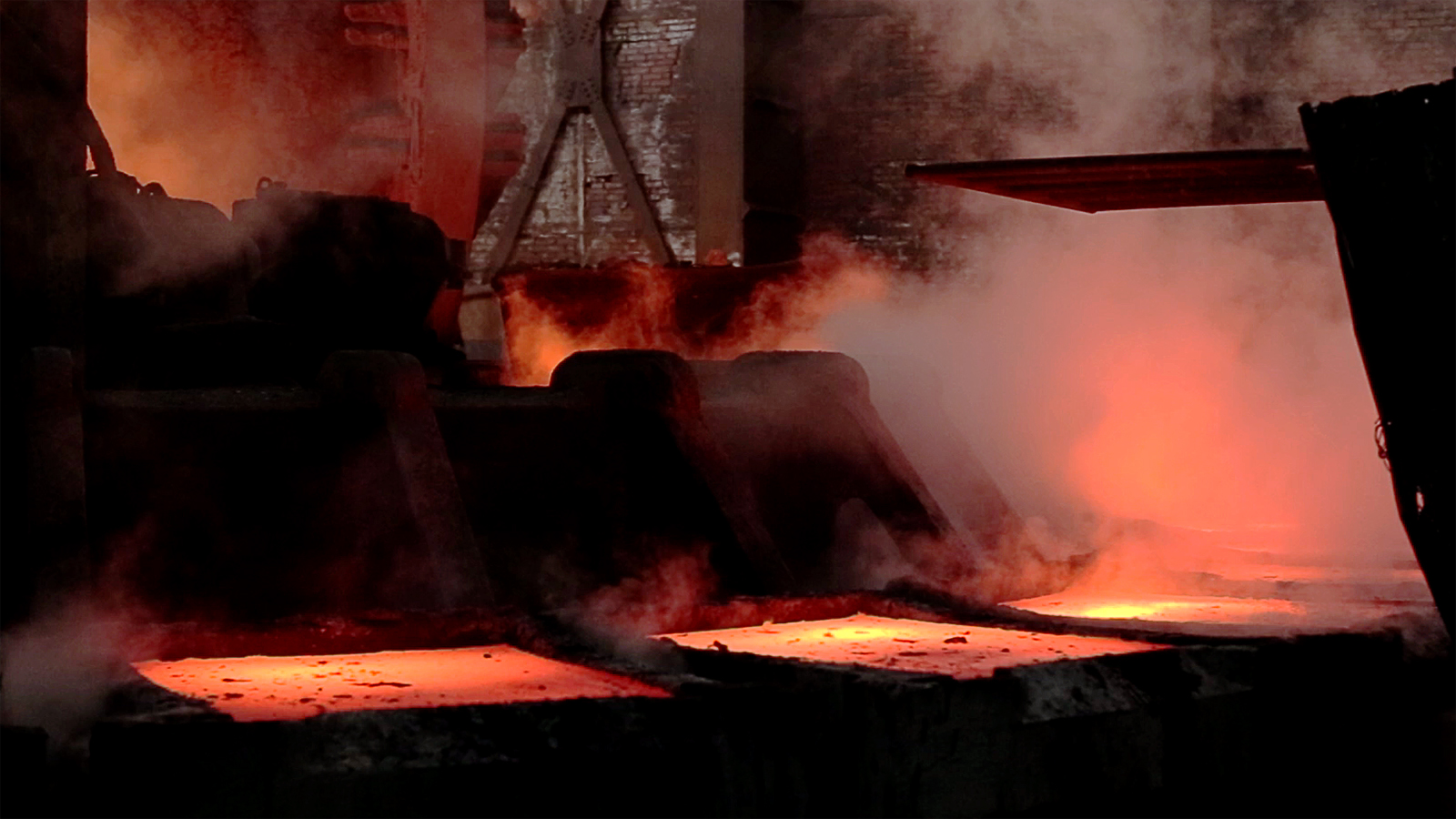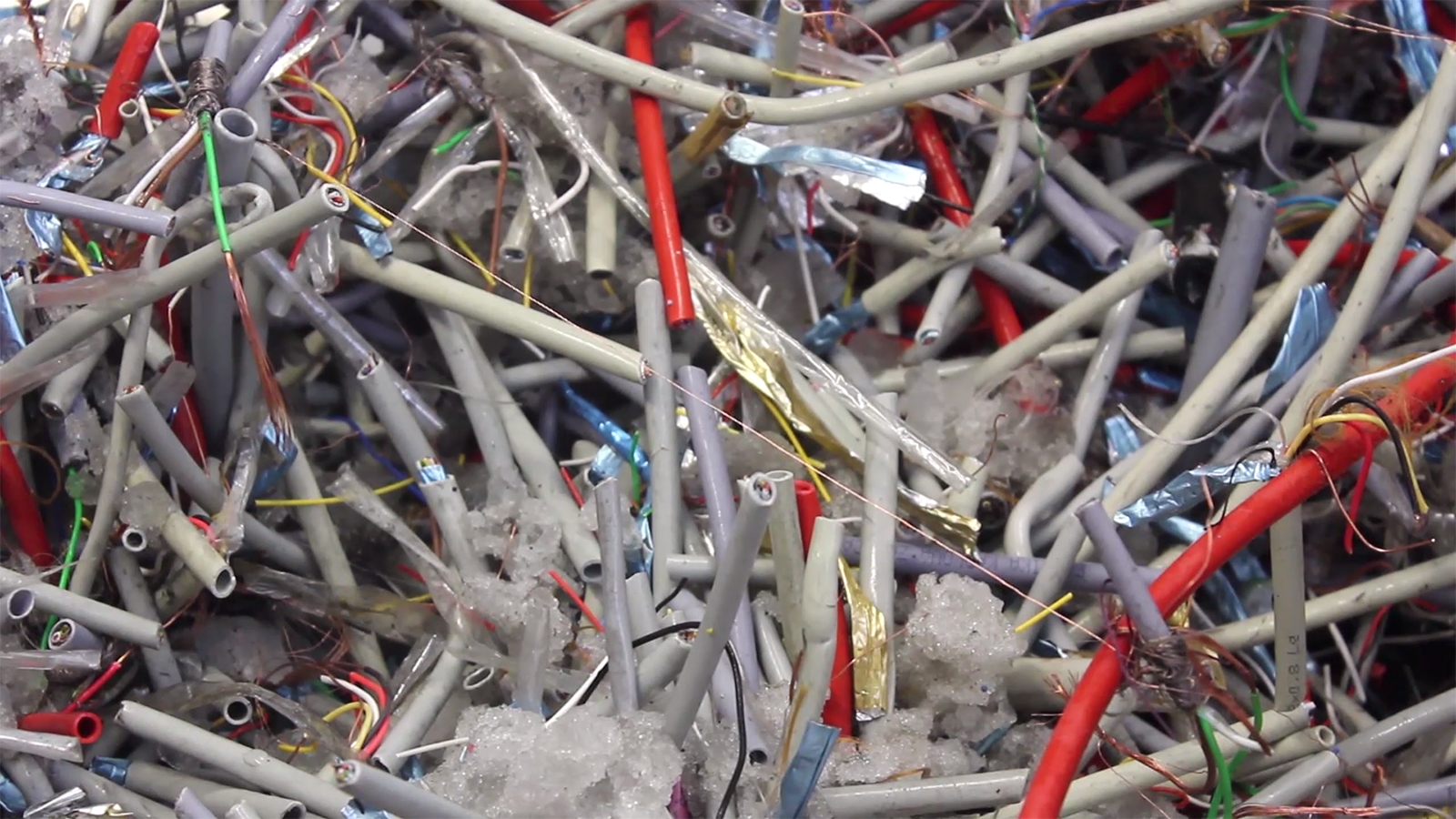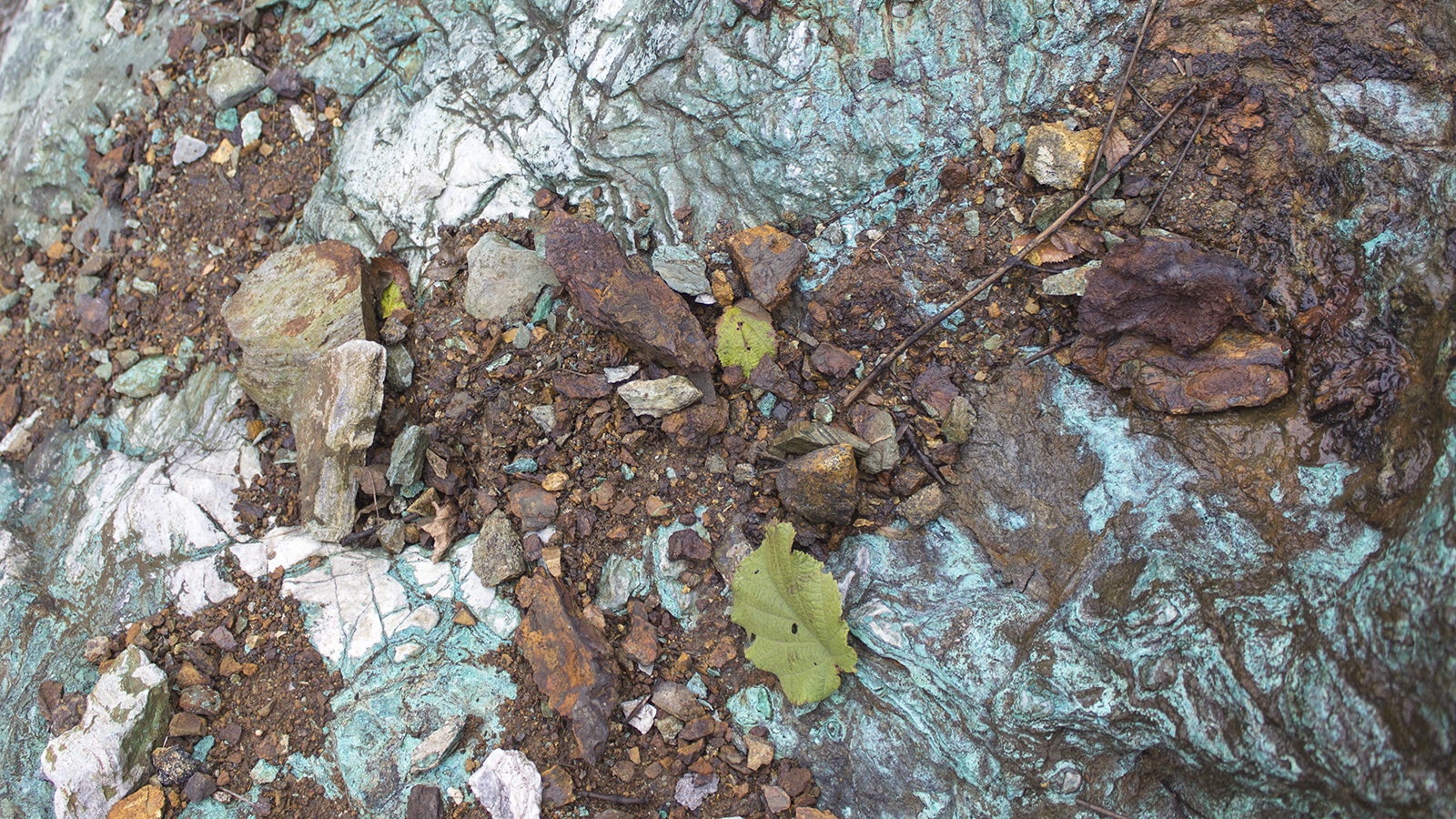Metal
mirko nikolić

The Metal Ages have never ended, late modernity is just another stratum in the continuum of humans' entwinement with copper, bronze, iron and other metallic earths. A computer chip contains more than 60 elements, out of 83 stable (nonradioactive) elements (Rohrig, 2015). Most of them are irreplaceable, at least on our planet (Graedel et al., 2013). Elements forged through nuclear reactions of stars and supernovae, millions of years of interplanetary "nonlinear history" (De Landa, 1997), gathered through mineralisations, are compressed into chips that run calculations in nanoseconds. And not only societies, for human bodies to begin with are "walking, talking minerals" (Margulis & Sagan, in Bennett, 2010, p. 11). As a species-being, humans, but also animals and vegetals are entangled with "metallic lives" (Bennett, 2010, p. 52-61). Yet, in the current technocapitalist socius, the dynamics of these intimate dependencies are at present comprehensively black-boxed, offshored, outsourced; and contribute to severe 'forcings' upon the earth.

The immense processing power of the Technosphere (Haff, 2014) is grounded in tentacular regimes of supply chains that root into what Jason Moore has called "Cheap Natures" (2015), embracing the planet geographically as well as cutting into the deep past and future. A zig-zagging yet continuous line runs from mines to electronic waste, enormous piles are fed by orders of magnitude in dumpsites, unevenly distributed, with peaks in Africa and China [1]. Exploration is under way in the North and in the South, in a quest to offset the declining ore grades, the focus shifts onto 'urban mining' as well to recircuit vast amounts of ICT devices which are "left to gather dust in the drawers" (Nichols, 2015). Mineral mining that underpins ICT is an elephant in almost every room, the result of trans-species intersectional pressures upon environmental and social ecologies. Wars are led for critical metals (one of most dramatic examples are the so-called 'coltan wars' in the Congo), tailing ponds of mineral mines spill out into surrounding waterways (among many, a disastrous spill into the surrounding lakes from zinc mine tailings in Talvivaara, Finland in 2012-3 and a massive chemical spill from a copper mine in Mexico, 2014), children are enslaved and exploited (World Vision, 2013), and, finally, electronic and electrical waste is dumped in China, Africa, Chile, and elsewhere. If we extend the notion of 'conflict' beyond war to include other forms of violence, the question arises whether there is such a thing as a 'conflict-free mineral' and, by extension, a piece of Information & Communication Technology at all? Naomi Klein's formula "keep it in the ground" (2014) thus extends to many more bodies beyond oil and shale gas. Speed of digital technology is in unfortunate ways correlated to the extent and profundity of "slow violence" (Nixon, 2013).

Through and beyond the materiality of minerals, the workings of ICT companies are also discursively correlated to the mining industry. For example, the 'mining' of data, or rather how we are mined for data. Beyond semiotic correspondence, mining data is a linear extension or transposition of a logic that begins with the digging of the earths. On the human end, internet users' activity is a resource, to be extracted, smelted (into datasets), sold, moulded into services, and resold to the same or different users. Contrary to the limits of resource ecologies, one of the reasons for the immense financial success of IT has been an ideology that there are no boundaries to data growth. "Users will share more and more", thus goes 'Zuckerberg's Law' (Hansell, 2008). There is no material nor semiotic discontinuum between data and mineral mining, they are part of a unique extractivist mind-set, akin to what Brett Bloom calls "petro-subjectivity" (2015). Extraction is hard-wired into the most mundane daily intra-actions with ICT devices and beyond. To further trouble who/what is the subject of mining, recent developments in bio-mining mobilise microbes, that is, life, in the process (Labban, 2014). We might ask, if metallic capacities or affects have inspired and fuelled operations of capitalist/imperialist appropriation by extraction, are there alternative modes to entangle with metallic earths, and, more broadly, with nonlife, outside of the apparatuses of extraction and accumulation?

A becoming of minoritarian metallic ecologies requires deep re(con)figurations of material-discursive relationalities among humans and earths. Alternate perspective to capitalist desires might be provided by metallic animacy, which, in environmental humanities, posits recognising "geologic life" (Yusoff, 2013). In Jane Bennett's vitalism, rocks are "vibrant," endowed with "thing-power" (2010). New materialist and geological turns should be able to explore the minor genealogies of metallic affects through the strata of power-knowledge. Even in European history, stories and philosophies that spoke of liveliness of lithic bodies were widespread across the continent until well into the 16th and 17th century, until early modernity and the advent of the Scientific Revolution (see, Cohen, 2015). These knowledges were persecuted by various disciplinary techniques,including an outright extermination of 'witches', until a mechanistic view of natural realityfinally prevailed (see, Merchant 1980; Federici, 2004). But, the question of nonlife was not finally settled, it runs throughout modernity, as we can observe in the lively disputes around the animacy of liquid crystals (Leslie, 2016). At the current moment the problem of mineral as nonlife reaches a novel intensity. Once again, or before, the problematic surrounding the animacy of earth is closely implicated in survival of entire communities, as we see, for example, in the struggles of Aborigines against settler colonial/extractivist "geontopower" (Povinelli, 2016), and the water and land ontologies of the First Nations agentialised by Standing Rock in North Dakota and the Coast Protectors in British Columbia. With Povinelli, the apparatuses of modernity have been based on Life vs. Death opposition, but what we are witnessing now, in the latter stages of neoliberal capitalism, is the struggle between Life and Nonlife (2016, p. 19). Learning from these histories of oppression and appropriation, extending agency to other-than-humans is a dangerous venturing into the territories where empire and capital reign. Metallic ontologies still belong to subjugated knowledges.
Metal flows and mineral becomings traverse the binary Life/Nonlife, and queer-feminist new materialism dedicated to envisioning climate and multispecies social justice needs to be response-able to these animacies beyond the paradigm of extraction. J.J. Cohen claims that stone induces "queer wonder", activating lines of desire that cross life and its supposed other, and in this Cohen sees a potential for ethico-political "inhuman collaborations", "promiscuously desiring alliance with rocks, texts, forces of nature as with humans living and dead" (2013, p. 154). These ecocritical, as well as creative, practices can be seen as ways of making kin with the inorganic (Bakke, 2017). In a naturalcultural continuum, forging inhuman collaborations would mean re-joining biological and social with the processes of what Robert M. Hazen and his team called "mineral evolution" (Hazen et al., 2008). According to their proposition for an alternative mineralogy, about two thirds of mineral diversity on the planet has come into being directly or indirectly related to biotic processes (ibid.). Life and nonlife have been entangled since the Eoarchean Era (~3.85-3.6 billion years ago) (ibid.).

Metals are endowed with conductivities, mobilities, ductilities that human bodies and minds cannot easily comprehend. Yet, they are present throughout us. If we were to follow Spinoza regarding metals and humans, wemight say we have things in common, and, from there,forming 'common notions', agreeable alliances of these heterogeneous bodies is possible. One of the ways to venture towards a specifically metallic onto-epistemology as well as ethico-polytics is through vegetal and microbial beings. Plants and microbes are deeply involved in transformations of metal from nonlife into life, they have partaken closely in 'mineral evolution', a still ongoing process. In relation to the entanglements of the biosphere, the animal too, has, and always has been a profoundly "geologic subject" (Yusoff, 2014), not a protagonist but a companion and collaborator. Metals are transcorporeal cyborgs that bridge and entangle – materially-discursively – life and nonlife in a shared history and contested present. Metallic common notions however hold possibilities of an open future in un/common. "The earth is transitioning" (Preciado, 2018), so too must geologic subjects.
Notes
1. According to United Nations Environment Programme, the Waste Electric or Electronic Equipment (WEEE) or simply 'e-waste' is the fastest growing material stream of waste on the planet. A 2015 report from the UN University estimates that about 90% of the global e-waste is illegally traded or dumped on the world level (Nichols, 2015). In 2014, 42 million tonnes of e-waste was produced (ibid.).
Images
Fig. 1. mineralizacija, mirko nikolić, Aleksandra Mitovski, Duško Jelen, Marika Troili, Tuomas Laitinen, CC BY-NC-ND 4.0.
Fig. 2. mineralizacija, mirko nikolić, Aleksandra Mitovski, Duško Jelen, Marika Troili, Tuomas Laitinen, CC BY-NC-ND 4.0.
Fig. 3. Bor, Serbia. mirko nikolić, CC BY-NC-ND 4.0.
Fig. 4. mineralizacija, mirko nikolić, Aleksandra Mitovski, Duško Jelen, Marika Troili, Tuomas Laitinen, CC BY-NC-ND 4.0.
Fig. 5. Rudna Glava, Serbia. mirko nikolić, CC BY-NC-ND 4.0.
Synonyms: earth, Gaia, conductor, Technosphere, resistor, capacitor, wire, connector, molecular nomadism, life-nonlife symbiogenesis
Antonyms: life–nonlife, extraction, data mining, capitalism, imperialism, circuit
References
911 Metallurgist. (2013). Mining your iPhone. Infographics at https://www.911metallurgist.com/wp-content/uploads/2015/07/Mining-your-iphone.jpg
Bakke, M. (2017) The Force of Radical Openness: Multispecies Alliances beyond the Biological. Keynote at Nonhuman Agents in Art, Culture and Theory Conference. Art Laboratory Berlin, 24 November 2017.
Bennett, J. (2010). Vibrant Matter. A Political Ecology of Things. Durham: Duke University Press.
Cohen, J.J. (2013) "Queering the Inorganic." In Killian, E., Yekani, E.H., & Michaelis, B. (eds.) Queer Futures: Reconsidering Normativity, Activism and the Political. Farnham: Ashgate, 2012, 149-164.
Cohen, J. J. (2015). Stone: An Ecology of the Inhuman. Minneapolis, MN; London: University of Minnesota Press.
Bloom, B. (2015). Petro-Subjectivity: De-Industrializing Our Sense of Self. Wayne, IN: Breakdown Break Down Press.
De Landa, M. (1997). A Thousand Years of Nonlinear History. New York: Zone Books.
Federici, S. (2004). Caliban and the Witch: Women, the Body and Primitive Accumulation. New York; London: Autonomedia.
Graedel, T. E., Harper, E. M., Nassar, N. T., & Reck, B. K. (2015). On the material basis of modern society. Proceedings of the National Academy of Sciences, 112(20), 6295–6300.
Haff, P. (2014). Humans and technology in the Anthropocene: Six rules. The Anthropocene Review, 1(2), 126–136.
Hazen, R.M., Papineau, D., Bleeker, W., Downs, R.T., Ferry, J.M., McCoy T.J., Sverjensky, D.A., Yang, H. (2008) Mineral evolution. American Mineralogist, 93, 1693-1720.
Klein, N. (2014). This Changes Everything: Capitalism vs. the Climate. London: Allen Lane.
Labban, M. (2014) Deterritorializing Extraction: Bioaccumulation and the Planetary Mine, Annals of the Association of American Geographers. 104 (3), 560-576.
Leslie, E. (2016). Liquid Crystals: The Science and Art of a Fluid Form. London: Reaktion Books.
Merchant, C. (1980). The Death of Nature: Women, Ecology, and the Scientific Revolution. San Francisco: Harper & Row.
Moore, J. W. (2015). Capitalism in the Web of Life: Ecology and the Accumulation of Capital. New York: Verso Books.
Nichols, W. (2015, February 19). How 125 million old smartphones are going to waste. Business Green. Retrieved from https://www.businessgreen.com/bg/analysis/2395955/how-125-million-old-smart-phones-are-going-to-waste
Nixon, R. (2013). Slow Violence and the Environmentalism of the Poor. Cambridge, Mass.: Harvard University Press.
Povinelli, E. A. (2016). Geontologies: A Requiem to Late Liberalism. Durham: Duke University Press.
Preciado, P.B. (2018) Baroque technopatriarchy: reproduction. Artforum, 56, 5. Available at: https://www.artforum.com/print/201801/baroque-technopatriarchy-reproduction-73189
Rohrig, B. (2015). Smartphones. Smart Chemistry. ChemMatters, 10–12. Retrieved from https://www.acs.org/content/acs/en/education/resources/highschool/chemmatters/past-issues/archive-2014-2015/smartphones.html
World Vision DRCongo. (2013). Child Miners Speak: Key Findings on Children and Artisanal Mining in Kambove DRC. Kinshasa. Retrieved from https://www.worldvision.ca/ABOUTUS/Media-Centre/Documents/Child-Miners-Speak.pdf
Yusoff, K. (2013). Geologic life: prehistory, climate, futures in the Anthropocene. Environment and Planning D: Society and Space, 31(5), 779–795.
Yusoff, K. (2014). Geologic subjects: nonhuman origins, geomorphic aesthetics and the art of becoming inhuman. Cultural Geographies, 22(3), 383–407. https://doi.org/10.1177/1474474014545301
COST Action IS1307 New Materialism: Networking European Scholarship on 'How Matter Comes to Matter'.
Here you will find background material, current activities, calls for papers, working group information, and project outputs.
With the changing of societies on local, national and international scales owing to economic, ecological, political and technological developments and crises, a reorganized academic landscape can be observed to be emerging. Scholarship strives to become increasingly interdisciplinary in order to grasp and examine the unfolding complexity of ongoing ecological, socio-cultural and politico-economic changes. Additionally, academics forge... Read more or find out Who's Who
- Call for Papers - Technology Matters and Matters of Technology: Exploring Theories of "Materiality" for Technology Research - June 25, 2018
- The return of materialism(s)? Matter between science, theory and art - University of Iceland
- Call for Entries - New Materialism Almanac 2018
- Urban Matters: Material Engagements with Communities and Borders in Times of Movement
Information relating to activities undertaken, including conferences, training schools, short-term scientific missions, and annual meetings, are archived here.
Filter activities by:
Conference7
Other7
STSM7
Training School7
- 7th Annual Conference: Performing Situated Knowledges: Space, Time, Vulnerability
- From Cosmos to Genes: New Materialist Methodologies Crossing the Humanities, Natural, and Technosciences
- MC Meetings: Barcelona, Maribor and Warsaw
- Training School 2: Research Genealogies and Material Practices
Working Groups focus on four key areas of research
Working Group One
Genealogies of New Materialisms; examines and intervenes in canonization processes by compiling a web-based bibliography, coordinating the OST 068/13 8 EN... Read more
Working Group Two
New Materialisms on the Crossroads of the Natural and Human Sciences; seeks to develop new materialisms at the boundaries of the human and natural sciences. The group focuses on how European new materialisms can rework the ‘Two Cultures' gap... Read more
Working Group Three
New Materialisms Embracing the Creative Arts; brings together European researchers, artists, museum professionals, and other activists with a keen interest in the material... Read more
Working Group Four
New Materialisms Tackling Economical and Identity – Political Crises and Organizational Experiments... Read more
2016–18
The Almanac comprises contributions from members of working groups, and participants in related activities, delineating key terms, more esoteric neologisms, and short provocations. Read more
New Materialism —
Networking European Scholarship on 'How matter comes to matter’

Website by Second Cousins

